BESTEK BNX-M81 User manual

1
Embedded Board
BNX-M81
Always at the forefront of innovation
User Manual

2
This publication contains information that is protected by copyright. No part of it may be reproduced in any
form or by any means or used to make any transformation adaptation without the prior written permission
from the copyright holders.
This publication is provided for informational purposes only. The manufacturer makes no representations or
warranties with respect to the contents or use of this manual and specifically disclaims any express or implied
warranties of merchantability or fitness for any particular purpose. The user will assume the entire risk of the
use or the results of the use of this document. Further, the manufacturer reserves the right to revise this
publication and make changes to its contents at any time, without obligation to notify any person or entity of
such revisions or changes.
© 2011. All Rights Reserved.
All trademarks and registered trademarks of products appearing in this manual are the properties of their
respective holders.
This equipment has been tested and found to comply with the limits for a Class A digital device, pursuant to
Part 15 of the FCC rules. These limits are designed to provide reasonable protection against harmful interference
when the equipment is operated in a residential installation. This equipment generates, uses, and can radiate
radio frequency energy and, if not installed and used in accordance with the instruction manual, may cause
harmful interference to radio communications. However, there is no guarantee that interference will not occur
in a particular installation. If this equipment does cause harmful interference to radio or television reception,
which can be determined by turning the equipment off and on, the user is encouraged to try to correct the
interference by one or more of the following measures:
Reorient or relocate the receiving antenna.
Increase the separation between the equipment and the receiver.
Connect the equipment into an outlet on a circuit different from that to which the receiver is connected.
Consult the dealer or an experienced radio TV technician for help.
Notice:
1. The changes or modifications not expressly approved by the party responsible for compliance could void
the user’s authority to operate the equipment.
2. Shielded interface cables must be used in order to comply with the emission limits.
Copyright
Trademarks
FCC and DOC Statement on Class A

3
1. Warranty does not cover damages or failures that are raised from misuse of the product, inability to use the
product, unauthorized replacement or alteration of components and product specifications.
2. The warranty is void if the product has been subject to physical abuse, improper installation, modification,
accidents or unauthorized repair of the product.
3. Unless otherwise instructed in this user’s manual, the user may not, under any circumstances, attempt to
perform service, adjustments or repairs on the product, whether in or out of warranty. It must be returned
to the purchase point, factory or authorized service agency for all such work.
4. We will not be liable for any indirect, special, incidental or consequential damages to the product that has
been modified or altered.
It is quite easy to inadvertently damage your PC, system board, components or devices even before installing
them in your system unit. Static electrical discharge can damage computer components without causing any
signs of physical damage. You must take extra care in handling them to ensure against electrostatic build-up.
1. To prevent electrostatic build-up, leave the system board in its anti-static bag until you are ready to install
it.
2. Wear an antistatic wrist strap.
3. Do all preparation work on a static-free surface.
4. Hold the device only by its edges. Be careful not to touch any of the components, contacts or connections.
5. Avoid touching the pins or contacts on all modules and connectors. Hold modules or connectors by their
ends.
Important:
Electrostatic discharge (ESD) can damage your processor, disk drive and other
components. Perform the upgrade instruction procedures described at an ESD
workstation only. If such a station is not available, you can provide some ESD protection
by wearing an antistatic wrist strap and attaching it to a metal part of the system chassis.
If a wrist strap is unavailable, establish and maintain contact with the system chassis
throughout any procedures requiring ESD protection.
Warranty
Static Electricity Precautions

4
To avoid damage to the system:
• Use the correct AC input voltage range.
To reduce the risk of electric shock:
• Unplug the power cord before removing the system chassis cover for installation or servicing. After installation
or servicing, cover the system chassis before plugging the power cord.
Battery:
• Danger of explosion if battery incorrectly replaced.
• Replace only with the same or equivalent type recommend by the manufacturer.
• Dispose of used batteries according to local ordinance.
Before using the system, prepare basic system components.
If the system comes as a barebone; that is, none of the key components, including processor, memory, and hard
drive has been pre-installed as part of your purchase, you will need to at least ensure a compatible counterpart
is located and installed.
You will also need a few external system peripherals intended for the use of the system, a common pool with
at least a keyboard, a mouse, and a monitor is thus suggested.
Safety Measures
Before Using the
System

5
Table of Content
Copyright ....................................................................................................................................................................
2
Trademarks ....................................................................................................................................................................
2
FCC and DOC Statement On Class A.............................................................................................................................. 2
Warranty ........................................................................................................................................................................ 3
Static Electricity Precautions......................................................................................................................................... 3
Safety Measures ............................................................................................................................................................ 4
Before Using the System Board..................................................................................................................................... 4
Table of Content ............................................................................................................................................................ 5
Chapter 1 General Information
1.1 Main
Feature ........................................................................................................................................................... 7
1.2
Specifications .......................................................................................................................................................
8
1.3 Board Layout ..................................................................................................................................................... 9
Chapter 2 Jumper Setting
2.1 Before You Begin ..................................................................................................................................... 11
2.2
Precautions.........................................................................................................................................................
11
2.3 Setting
Jumpers..................................................................................................................................................
12
2.4 Back Panel Connectors....................................................................................................................................... 13
2.5 Location of Jumpers and Connectors.............................................................................................................. 14
2.6 Jumpers........................................................................................................................................................... 16
2.7 Internal Connectors ........................................................................................................................................ 21
Chapter 3 Operation
3.1 System Memory.............................................................................................................................................. 29
3.2 Installing
Memory......................................................................................................................................
29
3.3 Installing LGA1150 Intel® Core-i CPU, Heat Sink, and Fan ............................................................................... 30
3.4 Adding Power Connectors .............................................................................................................................. 33
3.5 Adding PCIe/PCI Cards.................................................................................................................................... 34
3.6 Install a PCI Express Mini Card in the Full-Mini Card Slot............................................................................... 35
Chapter 4 BIOS Setup
4.1 Entering Setup ................................................................................................................................................ 38
4.2 Getting Help.................................................................................................................................................... 38
4.3 Control Keys .................................................................................................................................................... 38
4.4 The Main Menu............................................................................................................................................... 39
4.5 The Advanced Menu........................................................................................................................................ 40
4.6 The Chipset Menu..................................................................................................................................................... 44
4.7 The Boot Menu................................................................................................................................................ 46
4.8 The Security Menu .......................................................................................................................................... 48
4.9 The Save & Exit Menu...................................................................................................................................... 50

6
Chapter 1
General Information

7
Micro-ATX System Board
BNX-M81 is a standard Micro-ATX motherboard featuring Intel® H81 PCH chipset supports Intel® Gen-4
Core™ processor and two Dual Channel DDR3 SO-DIMM slots up to 16GB DDR3 1066/1333/1600MHz
SDRAM with Non-ECC support and integrated HD graphic controller.
Intel® Gen-4 LGA1150 Haswell Processor
Two DDR3 RAM Slots up to 16GB
Two SATA Ports: 2* SATA 3.0
Two Display Ports: VGA, DVI-D
Ten Series Ports: 2* Edge RS-232/422/485, 8* RS-232 Headers
Six USB 2.0 Ports: 6* Internal Ports
Four USB 3.0 ports: 4* Edge Ports
Two Realtek GbE LAN Ports
1* Full-sized miniPCIe Slot
1* Half-sized miniPCIe Slot
1* PCIe 3.0 X16 Slot
1* PCIe 2.0 X1 Slot
2* PCI Slots
1.1 Main Feature

8
Core Engine
Chipset
Intel® H81 PCH
Processor
Support Intel® Gen-4 Core i3, i5, i7, Pentium® , Celeron® Processor
Single LGA1150 Processor Socket
Memory
2x DDR3 1066/1333 SO-DIMM Slots, up to 16GB, Non-ECC/Non-Buffered Memory Module
Display
Intel® HD Graphics 4600
Ethernet
Controller
Onboard 2x Realtek RTL8111G GbE Controllers
Storage
SATA
2x SATA3 Ports
Expansion
PCIe X16
1x
PCIe X1
1x
PCI
2x
miniPCIe
1x Full-sized + 1x Half-sized
Edge I/O
PS/2
2x PS/2 for Keyboard and Mouse
COM
2x DB9 RS-232
Display
1x DB15 VGA + 1x DVI-I
USB
4x USB 3.0 Ports
LAN
2x RJ45 GbE
Audio
3x Audio Jacks
Internal I/O
Front Panel
1x Front Panel Switch/LED Header
LPT
1x Parallel Box Header
COM
8x RS-232 Pin Header
USB
6x USB 2.0 Pin Headers
Fan
3x Fan Connectors
Other
H/W Monitoring
Monitor temperature, voltage, and fan speed, auto-throttling control at CPU overheat
WDT
1 min increment from 1 to 255 min, 1 sec increment from 1 to 255 sec
Environment
Operating Temp.
0oC ~ 60oC
Storage Temp.
-20oC ~ 70oC
Humidity
10% ~ 90% (Non-Condensing)
Mechanical
Dimension
244mm (W) x 244mm (D)
1.2 Specifications

9
Figure 1.1: Board Layout of BNX-M81
1.3 Board Layout

10
Chapter 2
Preparation

11
A stable and clean working environment are essential. Dust and dirt can get into components and cause a
malfunction. Use containers to keep small components separated.
Adequate lighting and proper tools can prevent you from accidentally damaging the internal components. Most
of the procedures that follow require only a few simple tools, including the following:
A Philips screwdriver
A flat-tipped screwdriver
A set of jewelers Screwdrivers
A grounding strap
An anti-static pad
Using your fingers can disconnect most of the connections. It is recommended that you do not use needle-nosed
pliers to disconnect connections as these can damage the soft metal or plastic parts of the connectors.
Before working on internal components, make sure that the power is off. Ground yourself before touching any
internal components, by touching a metal object. Static electricity can damage many of the electronic
components. Humid environment tend to have less static electricity than dry
environments.
A grounding strap is
warranted whenever danger of static electricity exists.
Computer components and electronic circuit boards can be damaged by discharges of static electricity. Working
on the computers that are still connected to a power supply can be extremely dangerous. Follow the guidelines
below to avoid damage to your computer or yourself:
Always disconnect the unit from the power outlet whenever you are working inside the case.
If possible, wear a grounded wrist strap when you are working inside the computer case. Alternatively,
discharge any static electricity by touching the bare metal chassis of the unit case, or the bare
metal body
of any other grounded appliance.
Hold electronic circuit boards by the edges only. Never touch the components on the board unless it is
necessary to do so. Do not flex or stress the circuit board.
Leave all components inside the static-proof packaging that they shipped with until they are ready for
installation.
Use correct screws and do not over tighten screws.
2.1 Before You Begin

12
A jumper is the simplest kind of electric switch. It consists of two metal pins and a cap. When setting the jumpers,
ensure that the jumper caps are placed on the correct pins. When the jumper cap is placed on both pins, the
jumper is SHORT. If you remove the jumper cap, or place the jumper cap on just one pin, the jumper is OPEN.
Please see the following illustrations
The illustrations on the right
show a 2-pin jumper. When the
jumper cap is placed on both
pins, the jumper is SHORT. If
you remove the jumper cap, or
place
the jumper
cap on just
one pin, the jumper is OPEN.
Open (Off)
Short (On)
These illustrations show a 3-pin
jumper. Pins 1 and 2 are SHORT.
Table 2-1: Setting
Jumpers
2.3

13
1. PS/2 Mouse (Green)
2. DB15 VGA
3. DB9 RS-232
4. LAN1
5. LAN2
6. Line-In Jack
7. Line-Out Jack
8. Microphone Jack
9. 2* USB 3.0
10. 2* USB 3.0
11. DB9 RS-232
12. DVI-I
13. PS/2 Keyboard (Purple)
2.4 Back Panel Connectors

14
2.5 Locations Of Jumpers and Connectors

15
List of Onboard Connectors
1
AUDIO
Audio connectors
2
USB_LAN2
RJ45 LAN port (top) / USB 2.0 ports (buttom)
3
USB_LAN1
RJ45 LAN port (top) / USB 2.0 ports (buttom)
4
COM34
Serial ports
5
VGA_DVI
VGA port (top)/DVI port (buttom)
6
JCOM5
JRS23
JRS22
JRS27
JRS29
RS232/RS422/RS485 Select Jumper for COM4
7
COM5
Serial port cable connector #5
8
COM6
Serial port cable connector #6
9
JRS14
JRS15
JRS22
JRS19
JCOM3
RS232/RS422/RS485 Select Jumper for COM3
10
ATX_12V
4 pin power connector
11
COM8
Serial port cable connector #8
12
COM7
Serial port cable connector #7
13
JCOM6
COM6 Power Select jumper
14
COM9
Serial port cable connector #9
15
JCOM8
COM10 Power Select jumper
16
COM10
Serial port cable connector #10
17
CPU
Intel LGA 1155 socket
18
CPU_FAN
CPU fan connector
19
SODIMMA
DDR3 SO-DIMM slot
20
SODIMMB
DDR3 SO-DIMM slot
21
LPT
LPT connector
22
MIN_PCIE1
Mini PCi Express connector
23
MIN_PCIE2
Mini PCi Express connector
24
JRS9 LVDS
Enable Jumper
25
JRS10 LVDS
Enable Jumper
26
JRS8 LVDS
Enable Jumper
27
JRS7 LVDS
Enable Jumper

16
28
LVDS
LVDS connector
29
BKL_CN
LCD Inverter Connector
30
JRS6
LVDS Enable Jumper
31
ATX
24 pin main power connector
32
SYS_FAN2
System fan connector #2
33
SATA1/SATA2
SATA 3Gb/s connectors
34
F_PANEL
Front Panel header
35
GPIO_CNT
GPIO connector
36
F_USB3
Front USB 2.0 header #3
37
F_USB2
Front USB 2.0 header #2
38
F_USB1
Front USB 2.0 header #1
39
BATTERY
Battery socket
40
LPC
LPC connector
41
CI
Case open intrusion header
42
CLR_CMOS
Clear CMOS jumper
43
COM1
Serial port cable connector #1
44
COM2
Serial port cable connector #2
45
F_AUDIO
Front audio header
46
SPK_OUT
Audio Amplifier connector
47
PCI2
PCI 32bit/33MHz slot
48
PCI1
PCI 32bit/33MHz slot
49
PCIE1X1
PCI Express x1 slot
50
PCIE16X1
PCI Express x16 slot
51
SYS_FAN
System fan connector

17
►COM3 RS-232/422/485 Selection Jumper
JRS14/JRS15/JRS21/JRS19
Pin
Definition
1-2 Closed
RS-422/485
2-3 Closed
RS-232
JCOM3
Pin
Definition
1-2 Closed
RS-232
3-4 Closed
RS-422
5-6 Closed
RS-485
2.6 Jumpers

18
►COM5 RS-232/422/485 Selection Jumper
JRS23/JRS22/JRS27/JRS29
Pin
Definition
1-2 Closed
RS-422/485
2-3 Closed
RS-232
JCOM5
Pin
Definition
1-2 Closed
RS-232
3-4 Closed
RS-422
5-6 Closed
RS-485

19
►JCOM6 / JCOM8 Pin#9 (RI) Selection Jumper
Pin
Definition
1-2 Closed
5V
3-4 Closed
RI
5-6 Closed
12V
►JRS9 / JRS10 / JRS8 / JRS7 / JRS6 (LVDS Enable Jumper)
JRS6
Pin
Definition
1-2 Closed
Enable LVDS
2-3 Closed
Disable LVDS
JRS7 / JRS8 / JRS9 / JRS10
Jumper
1024 x 600
1024 x 768
JRS7
JRS8
JRS9
JRS10

20
►CLR_CMOS (Clear CMOS Jumper)
Pin
Definition
Open
Normal Operation
Close
Clear CMOS
Table of contents
Other BESTEK Motherboard manuals
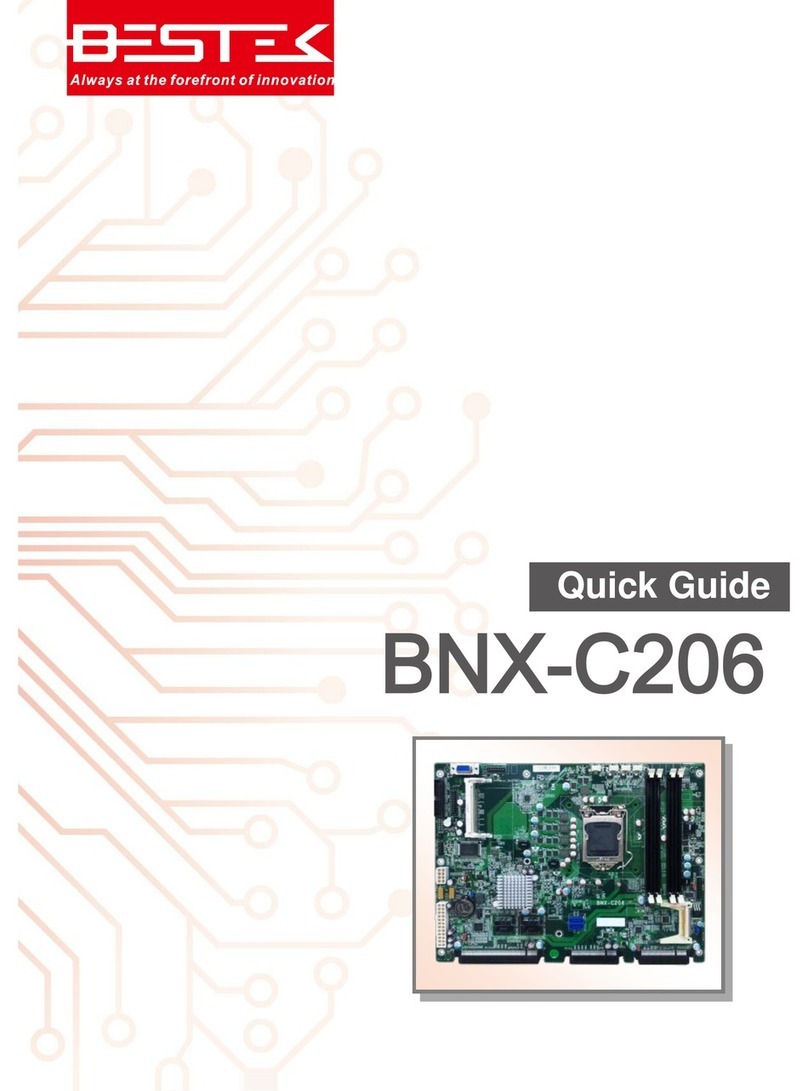
BESTEK
BESTEK BNX-C206 User manual
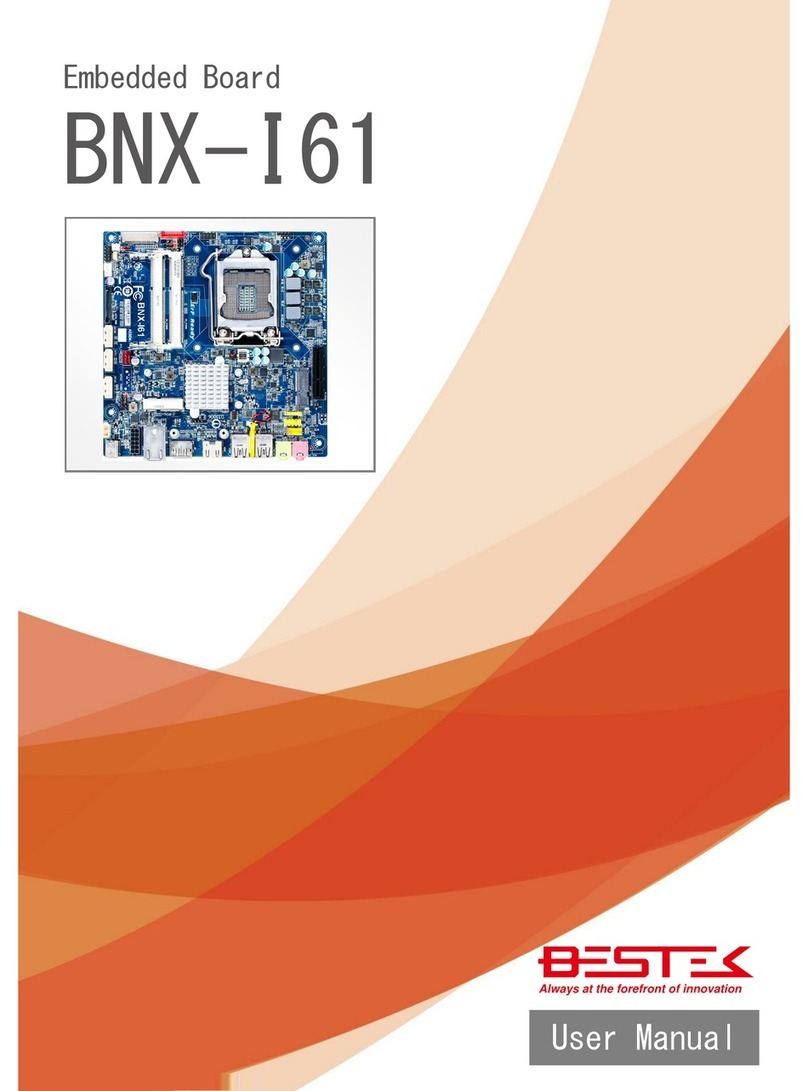
BESTEK
BESTEK BNX-I61 User manual
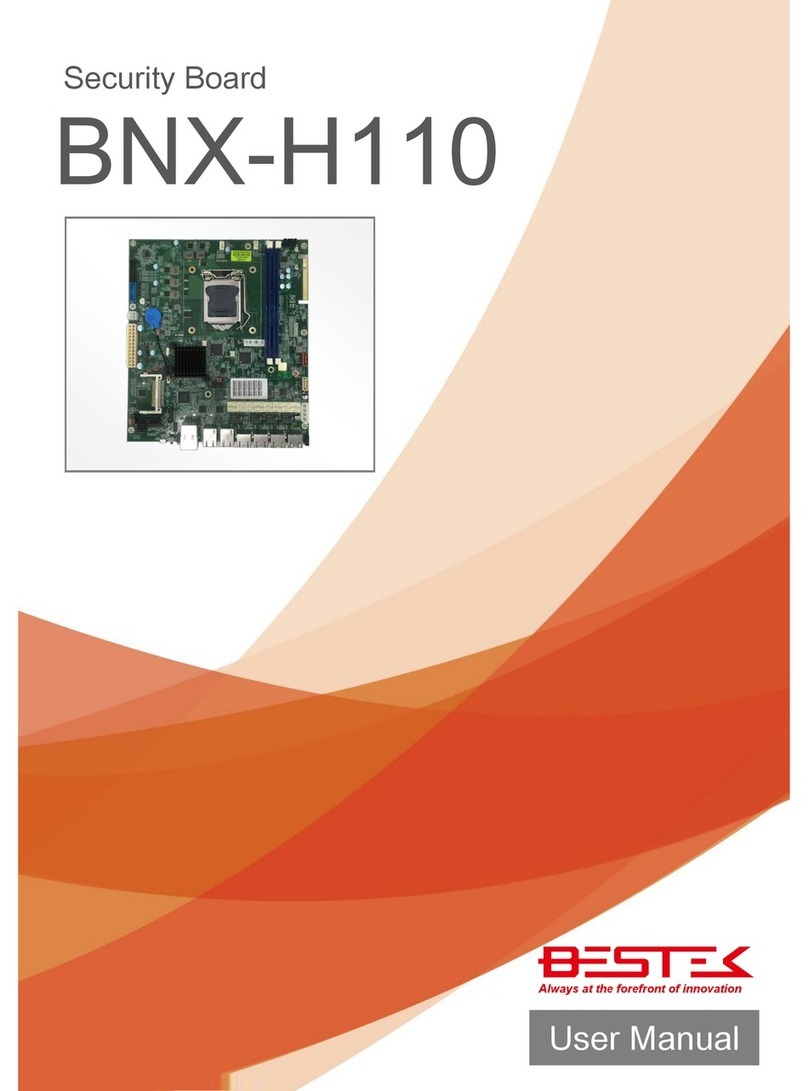
BESTEK
BESTEK BNX-H110 User manual
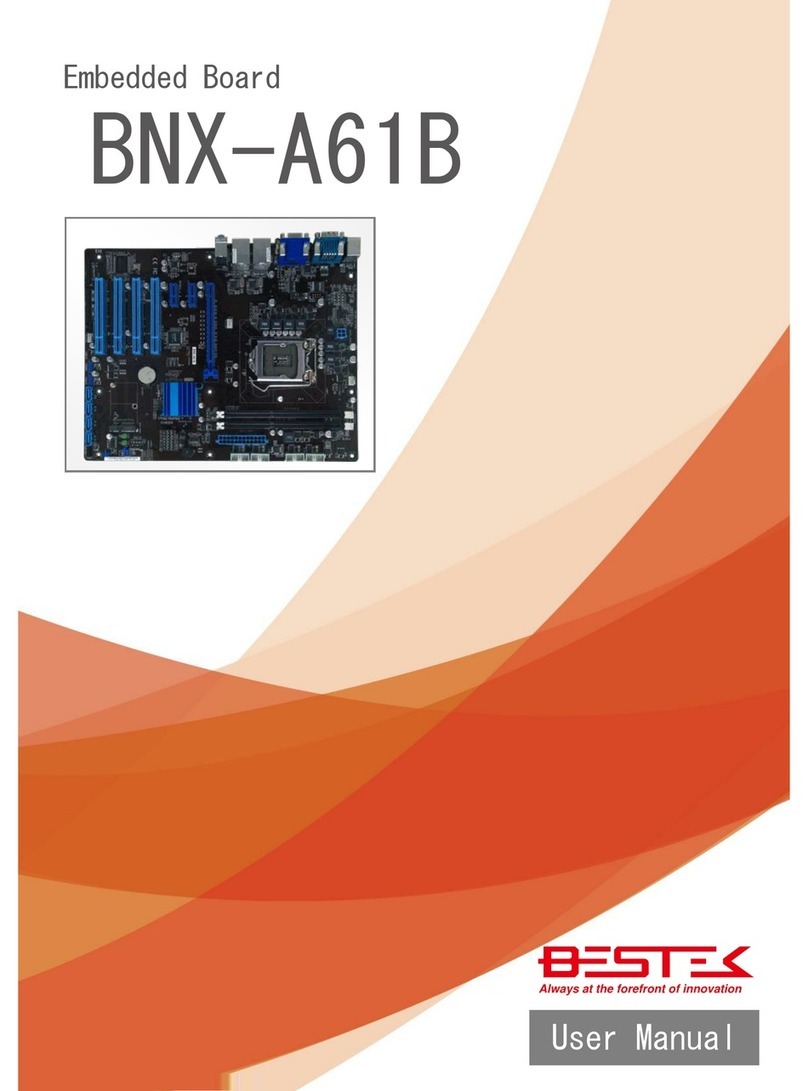
BESTEK
BESTEK BNX-A61B User manual
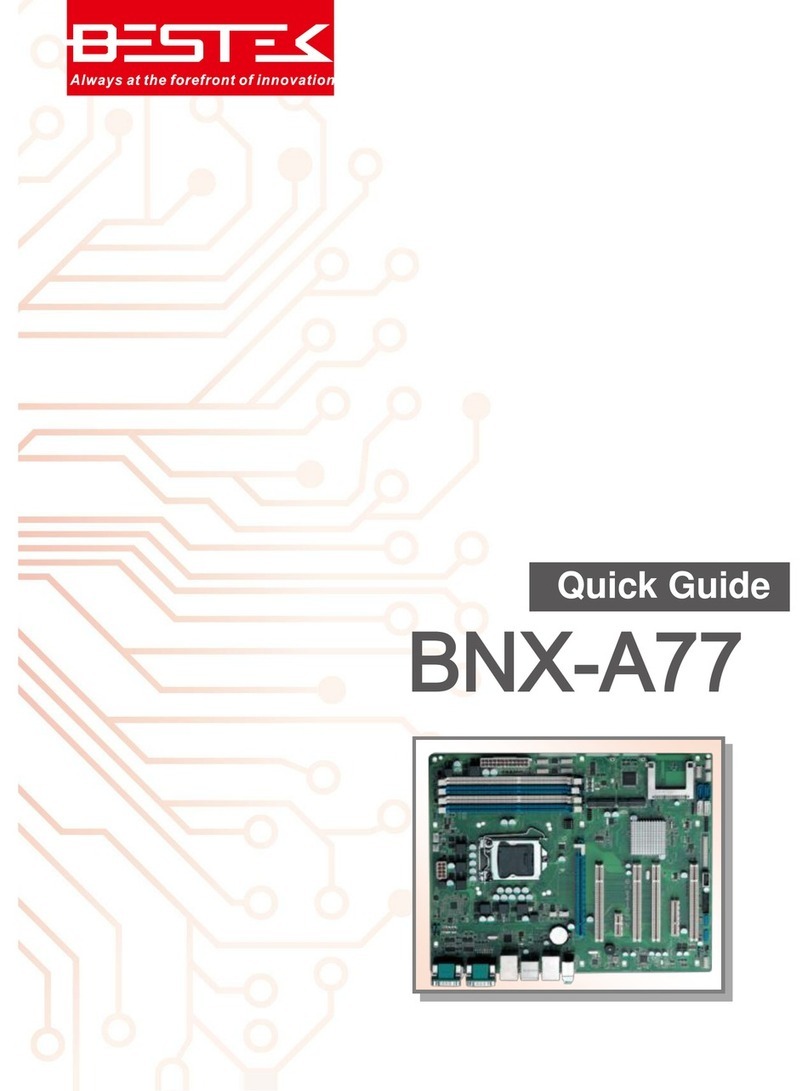
BESTEK
BESTEK BNX-A77 User manual
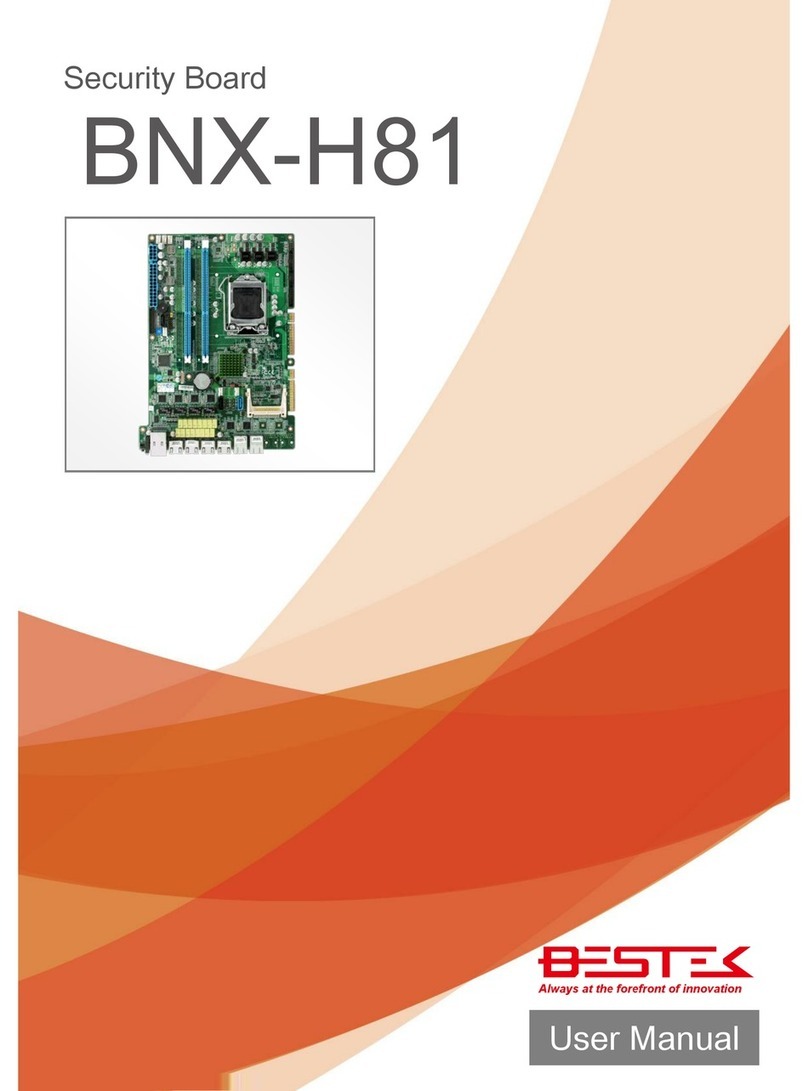
BESTEK
BESTEK BNX-H81 User manual
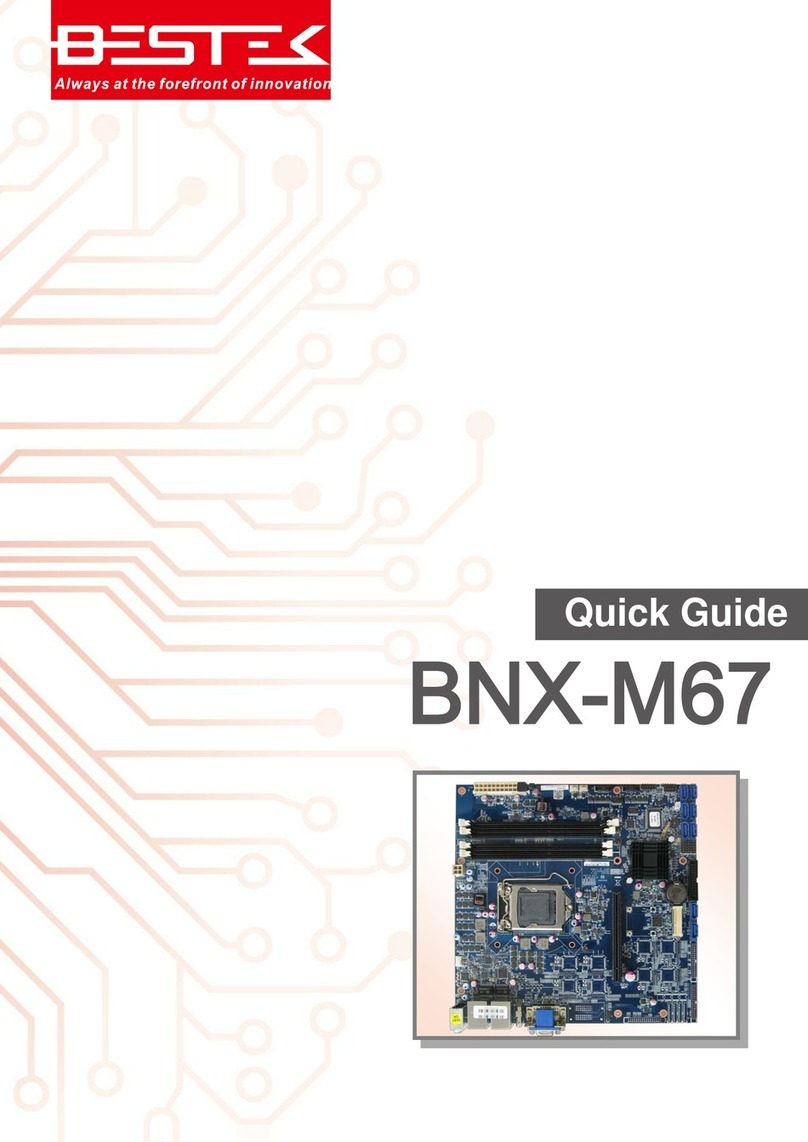
BESTEK
BESTEK BNX-M67 User manual
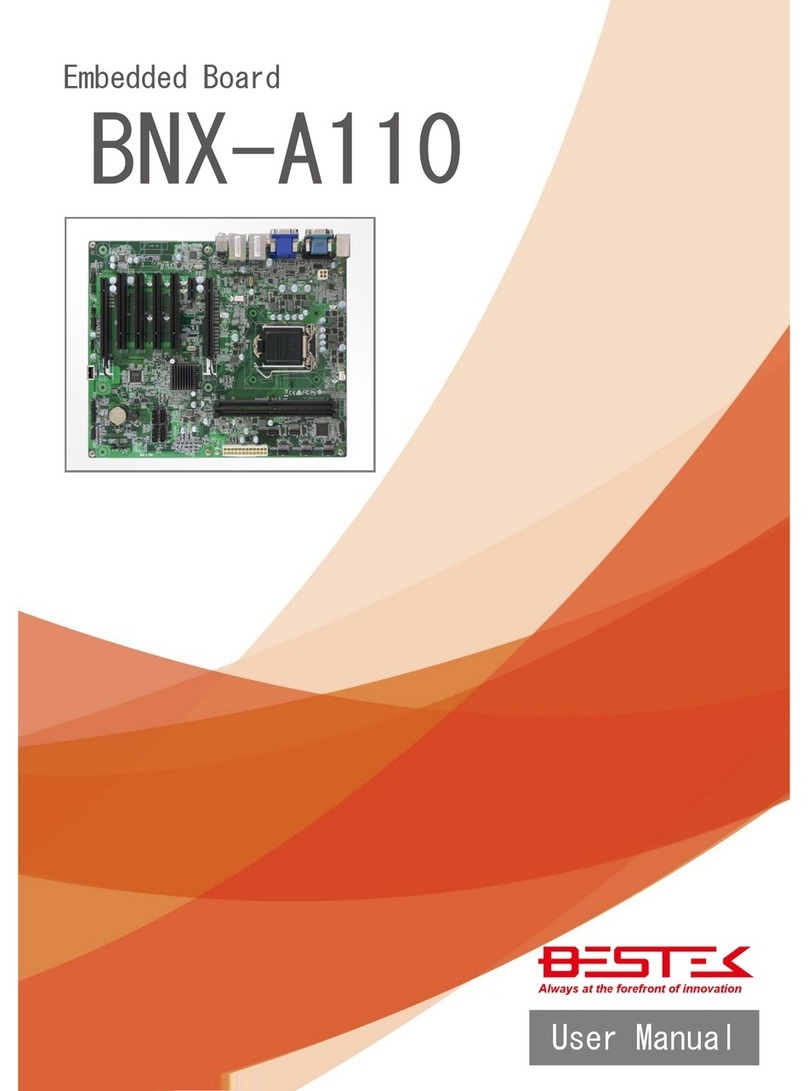
BESTEK
BESTEK BNX-A110 User manual

BESTEK
BESTEK BNX-M67 User manual
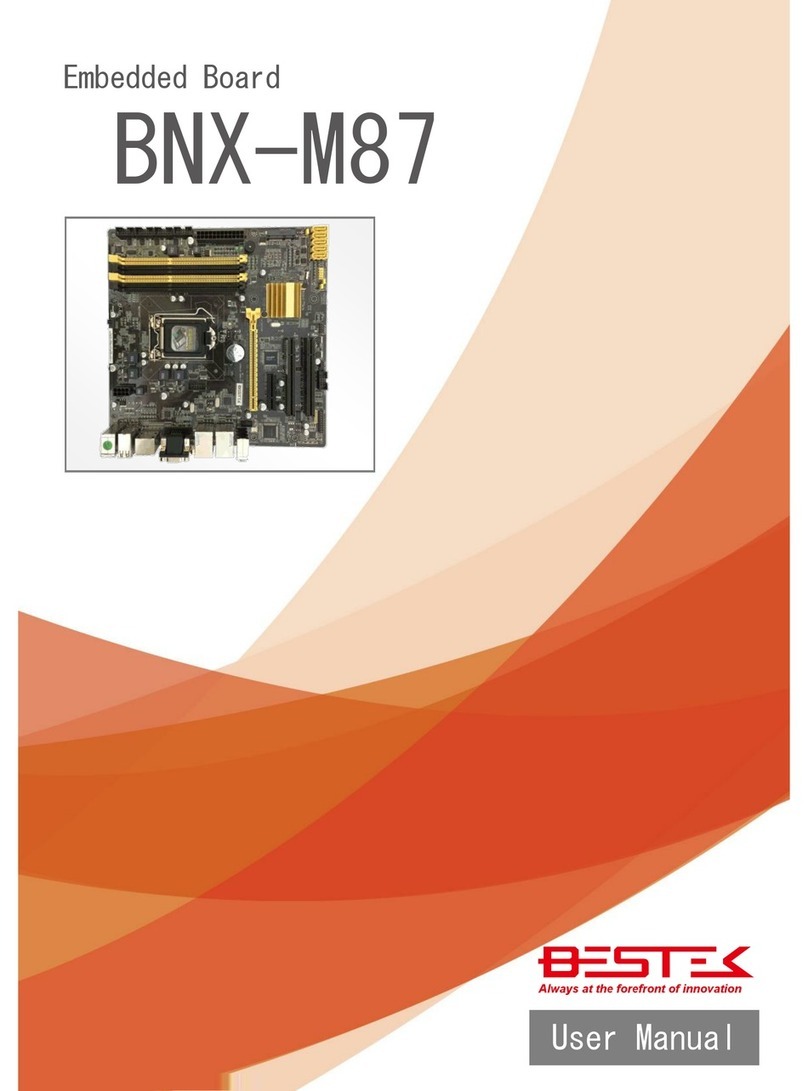
BESTEK
BESTEK BNX-M87 User manual


















